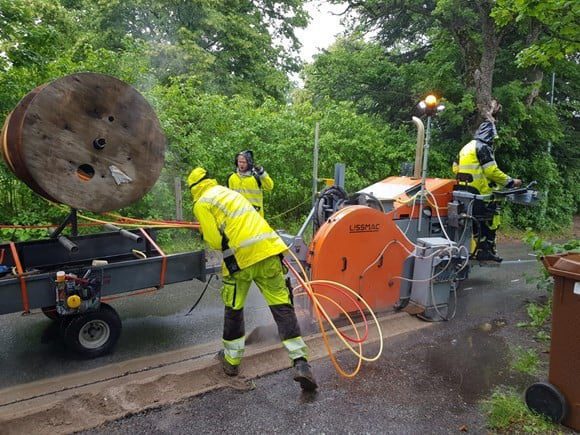More than 58,800 households and businesses across Dumfries and Galloway were reached by the £463 million Digital Scotland Superfast Broadband, final programme data released today revealed.
They were among over 950,600 homes and business across Scotland covered by the programme since it began in 2014, including more than 150,000 extra premises than planned.
Engineers from Openreach laid more than 1214km of cable across Dumfries and Galloway during the build, connecting communities including villages like Auchencairn, Castle Douglas and Parkgate.
Across Scotland more than 16,730km of new cable was laid – enough to stretch past Brisbane in Australia. The build included 400km of sub-sea cable to connect Scottish islands and 5,078 new fibre street cabinets, offering broadband services at speeds up to 80Mbps1.
Today, as it draws to a close, the huge civil engineering project was hailed as being central to tackling the exceptional national challenges imposed by the pandemic.
Business Minister Ivan McKee said: “The DSSB programme has been truly outstanding. It exceeded expectations, in the end delivering fibre broadband to more than 950,600 homes and businesses across Scotland.
“The way we work and live our lives has changed dramatically in the past year, and by providing decent, reliable broadband the DSSB programme has helped many people to work, learn and stay in touch with family and friends from their own homes.”
Mr McKee added: “Today, I’m delighted to be with our delivery partners Openreach. Across the country more than 97% of homes and businesses now have access to fibre-based broadband and the transformative benefits for work and social life it offers.
“As we look towards our recovery from the impacts of the global pandemic, good connectivity will continue to be essential in helping us to renew, restart and rebuild.”
When the programme first began in April 2014, only 26% of Dumfries and Galloway households and businesses were scheduled to get fibre broadband from a commercial provider.
The programme has ensured 96.8%[1] of homes and businesses in Dumfries and Galloway have access to fibre-enabled broadband, providing superfast access (greater than or equal to 24Mbps), for 87.1[2]% of which 86.2%[3] is at speeds greater than or equal to 30Mbps.
The programme’s target to bring fibre-based broadband services to 95 per cent of Scottish homes was completed on track at the end of 2017. But, thanks to efficiencies and reinvestment driven by strong take-up, the build continued into 2020, benefiting thousands of additional households and businesses.
Many of the properties reached in its final year – including in Bridge of Dee, Lochfoot, Waterbeck can connect to ultrafast, full fibre technology.
Robert Thorburn, Partnership Director for Openreach in Scotland, said: “Everyone at Openreach is thrilled to see the transformative effect of better broadband across Dumfries and Galloway.
“This has been a great partnership, going much further than planned and reaching many thousands of homes which might otherwise have struggled through the pandemic. Good connectivity has never been more important, and the huge expansion of the fibre network leaves a strong legacy to build on, including the deployment of 4G services in remote areas.
“We’re cracking on with the next stage of the journey, and I’d like to say a massive thank-you to all the engineers who’ve overcome so many challenges – from wildlife and weather to terrain and red tape – to bring us this far.”
Councillor Rob Davidson, Chair of Dumfries and Galloway Council’s Economy and Resources said: “The DSSB programme has helped connect many of our rural villages, including Dunscore, Eskdalemuir. It means communities like Parton and Bentpath are now able to receive fibre-based broadband, whether that’s to Skype loved ones, learn online or work from home. Without the DSSB programme, they would have suffered slow speeds and poor connections.
“COVID has impacted on all of us and the past year has been incredibly difficult for all communities. I’m in no doubt that without the DSSB improvements to our rural broadband infrastructure life would have been so much harder for most of our residents.
“The difference it has made here is significant and quite phenomenal – it’s been central to meeting this exceptional national challenge.”
Sara Budge, DSSB Programme Director, said: “It has been a great pleasure for me to work on the DSSB programme. From the very first cabinet launch to seeing over 950,600 homes and businesses able to receive fibre broadband, it is transforming lives and delivering significant economic and social benefits.
“It’s particularly pleasing to see this in rural areas and rural market towns and villages such as Parton and communities like Kirkholm that without our programme would not have been able to reap the benefits of fibre broadband – particularly needed in the times we find ourselves.
“There’s lots of competition out there and now that everyone is having to spend more time at home and indoors they may find they could be surfing, learning and working at much higher speeds at a similar cost to their current service. Upgrades aren’t automatic, so customers should contact one or more service providers to explore the options available to them.”
Fibre technology offers fast and reliable connections at a range of speeds1 and there are many suppliers in the marketplace to choose from. Local people can check if the new fibre services are available to them at www.scotlandsuperfast.com/yourstreet.
BT Group has invested £146 million in the rollout, with digital network subsidiary Openreach delivering it on the ground.
Delivered through two projects – led by Highlands and Islands Enterprise in its area and the Scottish Government in the rest of Scotland – funding partners also include the UK Government through Building Digital UK (BDUK), local authorities and the EU via the European Regional Development Fund.






